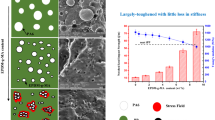Abstract
Rheological techniques, size-exclusion chromatography, and molecular spectroscopy are the most widely used tools for describing polymer molecular structure in polyolefins. The detection of long-chain branching, and to some extent, its quantification, have been based on quantifying the deviation of polyethylene’s (PE) rheological behavior from that of a linear reference. Although metallocene-based PE has been extensively studied, linear polydisperse originating from Ziegler or Chromium-based catalysts are not often thoroughly considered, despite their high industrial importance. Within this work, we study the linear and non-linear rheology of a set of polydisperse PEs, for which the topological linearity is confirmed by GPC-MALLS measurements. Thus, we can safely quantify the effect of broad molecular weight distribution, high and ultra-high molecular weight fractions on rheological quantities and model parameters. Specifically, the zero-shear viscosity, η 0 vs. M w, relaxation spectra, phase lag vs. the complex modulus plot (van Gurp–Palmen method) were applied and significant deviations from the “rheologically linear” behavior were observed, attributed only to M w, M z and polydispersity. Since the elongational viscosity was typical of linear PE, large-amplitude oscillatory shear and FT-Rheology were applied to quantify the non-linear rheological behavior. The latter was described by a single parameter, \(Q=I_{3/1}/\gamma_0^2\), which for linear polydisperse PE was correlated to the high molecular weight fraction and was constant over a broad range of applied Deborah numbers for the respective excitation frequencies. Since we need to correlate structural features such as broad MWD and HMW to polymer performance under processing conditions, we have to extend the analysis of linear rheological parameters, such as zero-shear viscosity, to non-linear parameters, e.g., the Q parameter quantified and used here.













Similar content being viewed by others
References
Baumgaertel M, Winter HH (1989) Determination of discrete relaxation and retardation time spectra from dynamic mechanical data. Rheol Acta 28:511
Fleury G, Schlatter G, Muller R (2004) Non linear rheology for long chain branching characterization, comparison of two methodologies: Fourier transform rheology and relaxation. Rheol Acta 44:174
Gabriel C, Kokko E, Löfgren B, Seppälä J, Munstedt H (2002) Analytical and rheological characterization of long-chain branched metallocene-catalyzed ethylene homopolymers. Polymer 43:6383
Gabriel C, Münstedt H (2003) Strain hardening of various polyolefines in uniaxial elongational flow. J Rheol 47:619
Hyun K, Wilhelm M (2009) Establishing a new mechanical nonlinear coefficient Q from FT-rheology: first investigation of entangled linear and comb polymer model systems. Macromolecules 42:411
Janzen J, Colby RH (1999) Diagnosing long-chain branching in polyethylenes. J Mol Structure 485–486:569–584
Kazatchkov IB, Bohnet N, Goyal SK, Hatzikiriakos SG (1999) Influence of the molecular structure on the rheological and processing behavior of polyethylene resins. Polym Eng Sci 39:804
Klimke K, Parkinson M, Spiess HW, Piel C, Kaminsky W, Wilhelm M (2006) Optimised polyolefin branch quantification by melt-state 13C NMR Spectroscopy. Macromol Chem Phys 207:382
Léonardi F, Majesté JC, Allal A, Marin G (2000) Rheological models based on the double reptation mixing rule: the effects of a polydisperse environment. J Rheol 44:675
McLeish TCB, Larson RG (1998) Molecular constitutive equations for a class of branched polymers: the pom-pom polymer. J Rheol 42:82
Münstedt H, Auhl D (2005) Rheological measuring techniques and their relevance for the molecular characterization of polymers. J Non-Newton Fluid Mech 128:62
Park SJ, Larson RG (2005) Modeling the linear viscoelastic properties of metallocene-catalyzed high density polyethylenes with long-chain branching. J Rheol 49:523–536
Piel C, Stadler FJ, Kaschta J, Rulhoff S, Münstedt H, Kaminsky W (2005) Structure–property relationships of linear and long-chain branched metallocene high-density polyethylenes characterized by shear rheology and SEC-MALLS. Macromol Chem Phys 207:26
Pollard M, Klimke K, Graf R, Spiess HW, Wilhelm M, Sperber O, Piel C, Kaminsky M (2004) Observation of chain branching in polyethylene in the solid state and melt via 13C NMR spectroscopy and melt NMR relaxation time measurements. Macromolecules 37:813
Stadler FJ, Piel C, Kaminsky W, Münstedt H (2006a) Rheological characterization of long-chain branched polyethylenes and comparison with classical analytical methods. Macromol Symp 236:209
Stadler FJ, Piel C, Kaschta J, Rulhoff S, Kaminsky W, Münstedt H (2006b) Dependence of the zero shear-rate viscosity and the viscosity function of linear high-density polyethylenes on the mass-average molar mass and polydispersity. Rheol Acta 45:755
Trinkle S, Friedrich C (2001) Van Gurp–Palmen-plot: a way to characterize polydispersity of linear polymers. Rheol Acta 40:322
van Dusschoten D, Wilhelm M (2001). Increased torque transducer sensitivity via oversampling. Rheol Acta 40:395
Vega JF, Santamaria A, Munoz-Escalona A, Lafuente P (1999) Rheological criteria to characterize metallocene catalyzed polyethylenes. Macromol Chem Phys 200:2257–2268
Vittorias I, Lilge D (2008) On the use of indexes for quantifying long-chain branching in polyethylene: can we describe the rheology of LCB PE and correlate it to processing performance by using a single number? AIP Conf Proc 1027:345
Vittorias I, Wilhelm M (2007) Application of FT rheology to industrial linear and branched polyethylene blends. Macromol Mater Eng 292:935
Vittorias I, Parkinson M, Klimke K, Debbaut B, Wilhelm M (2006) Detection and quantification of industrial polyethylene branching topologies via Fourier-transform rheology, NMR and simulation using the pom-pom model. Rheol Acta 46:321
Zimm BH, Stockmayer WH (1949) The dimensions of chain molecules containing branches and rings. J Chem Phys 17
Acknowledgements
The authors would like to acknowledge the help of Dr. Lars Kölling, Dr. Harald Schmitz and Dr. Jens Wiesecke on providing with samples. We are also grateful to Wolfgang Buderus for the GPC-MALLS measurements and Oliver Arnolds for a part of the linear rheological measurements. Finally, I. Vittorias and D. Lilge would like to acknowledge the support of Basell Polyolefine GmbH, a company of LyondellBasell.
Author information
Authors and Affiliations
Corresponding author
Rights and permissions
About this article
Cite this article
Vittorias, I., Lilge, D., Baroso, V. et al. Linear and non-linear rheology of linear polydisperse polyethylene. Rheol Acta 50, 691–700 (2011). https://doi.org/10.1007/s00397-011-0561-2
Received:
Revised:
Accepted:
Published:
Issue Date:
DOI: https://doi.org/10.1007/s00397-011-0561-2




